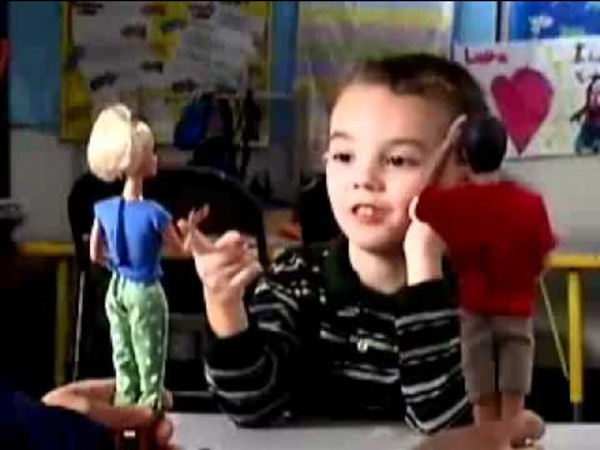



http://www.youtube.com/watch?v=-VqsbvG40Ww
Related: The Social Learning Theory : The development of gender roles and identities in children • How do children learn about gender roles and identities?Gender Roles - an overview 5.1.2 Effects of gender identity on behavior Gender roles also create sex differences in behavior when people adopt them as gender identities. Masculine and feminine identities guide behavior through self-regulatory processes. That is, people use their gender identity as a personal standard by against which to evaluate and guide their behavior (Moretti & Higgins, 1999; Wood, Christensen, Hebl, & Rothgerber, 1997). Just as agency and communion are typical themes of social expectations, people commonly internalize aspects of gender roles involving agency and communion (Wood & Eagly, 2009). Men on average describe themselves as relatively agentic, and women on average describe themselves as relatively communal, as shown by Twenge's (1997b) meta-analysis of gender identity measures that assess self-reports in these traits (e.g., Bem, 1974; Spence & Helmreich, 1978).
Feminine Traits & Stereotypes Our society has a set of ideas about how we expect men and women to dress, behave, and present themselves. What are gender roles? Gender roles in society means how we’re expected to act, speak, dress, groom, and conduct ourselves based upon our assigned sex. For example, girls and women are generally expected to dress in typically feminine ways and be polite, accommodating, and nurturing. Men are generally expected to be strong, aggressive, and bold. Gender stereotypes in mass media. Case study: Analysis of the gender stereotyping phenomenon in TV commercials. Mass media play a significant role in a modern world, by broadcasting information in fast pace and giving entertainment to vast audiences. They consist of press, television, radio, books and the Internet. The latter is now the most developing medium, however, TV also has a wide field of influence. By creating a certain type of message, media can manipulate people’s attitude and opinions.
List of Gender Stereotypes Simply put, gender stereotypes are generalizations about the roles of each gender. Gender roles are generally neither positive nor negative; they are simply inaccurate generalizations of the male and female attributes. Since each person has individual desires, thoughts, and feelings, regardless of their gender, these stereotypes are incredibly simplistic and do not at all describe the attributes of every person of each gender. Harmful Gender Norms & Roles Can Create a Lifelong Cycle of Gender Inequality All children deserve to grow up and achieve their dreams – regardless of their gender. Tragically, inequitable gender norms rob millions of girls and boys of their childhoods – and risk their futures. Often, these damaging expectations directly contribute to the violation of children’s human rights. Gender norms describe how people of a particular gender and age are expected to behave in a given social context. Harmful gender norms result in many types of inequalities between girls and boys.
Children, Television and Gender Roles A critical review of the available evidence concerning what influence television may have on the development of children's understanding of gender roles and of their own gender identity The society in which we live plays an enormous role in shaping the attitudes and behaviour of all those who are a part of it. Humans, as social beings, are constantly being bombarded with information from the environment which can influence the way we perceive the world and also shape our attitudes and beliefs, gradually moulding each and everyone of us into an 'accepted' member of society. In the past these influences which dictate how we should behave in a 'normal' society have emanated from sources such as the community, family and school. However, in today's world, the influences these institutions have seem to be declining as our changing society adapts to a more technological age. This is, however, what the social learning school of thought believe.
Effects of Gender Stereotypes Gender stereotypes are sets of cultural expectations popularly adopted by the mass majority. These roles and expectations are kept in place partly because of the human need to belong. Some cultures have restricting gender stereotypes, while others have become more lenient and accepting of deviation from gender roles. Gender Roles in Media Media plays a large role in creating social norms, because various forms of media, including advertisements, television, and film, are present almost everywhere in current culture. Gender roles, as an example, exist solely because society as a whole chooses to accept them, but they are perpetuated by the media. Conspicuous viewers must be aware of what the media is presenting to them, and make sure they’re not actively participating in a culture of oppression.
Children and gender identity: Supporting your child Children and gender identity: Supporting your child Understand the importance of talking with your child about gender identity and expression — and how to get the conversation started. By Mayo Clinic Staff If your child has questions about gender identity or gender expression, you've probably got questions, too.
What media teach kids about gender can have lasting effects, report says It's not just one movie. It's not just one TV show. It's constant exposure to the same dated concepts in the media over and over, starting before preschool and lasting a lifetime -- concepts like: Boys are smarter than girls; certain jobs are best for men and others for women; and even that girls are responsible for their own sexual assaults. According to the report, which analyzed more than 150 articles, interviews, books, and other social-scientific research, gender stereotypes in movies and on TV shows are more than persistent; they're incredibly effective at teaching kids what the culture expects of boys and girls. What makes these messages stick -- and harder for parents to counteract -- is that they're timed for the precise moment in kids' development when they're most receptive to their influence. Think of preschoolers who are just beginning to identify as boys or girls.